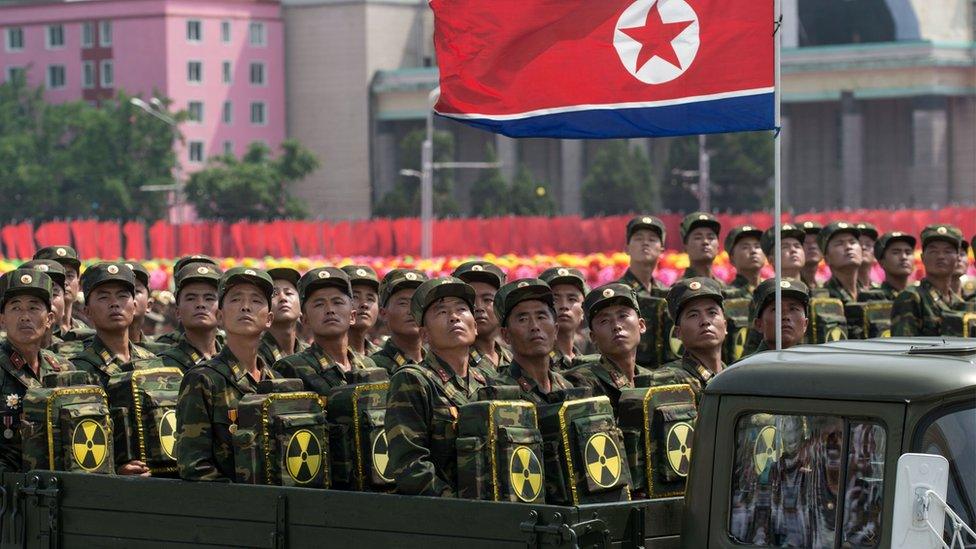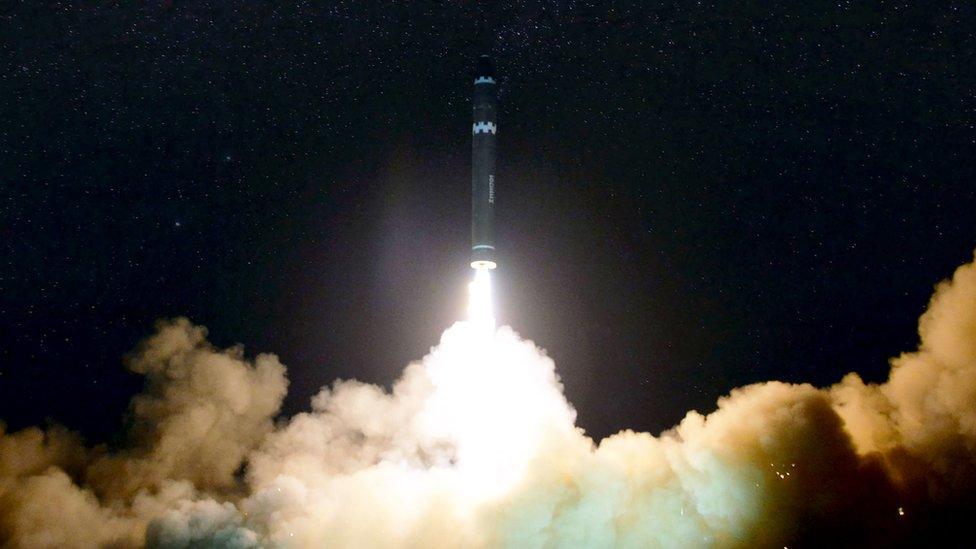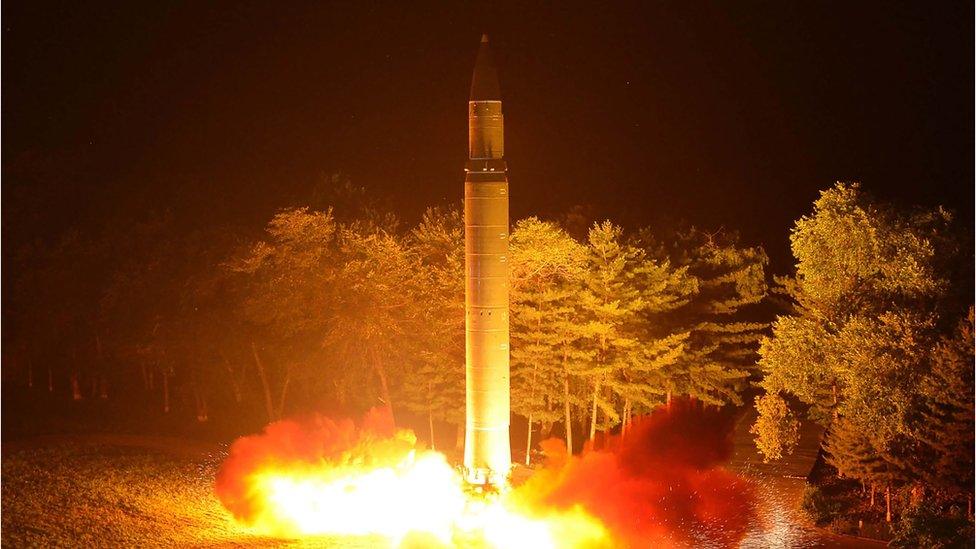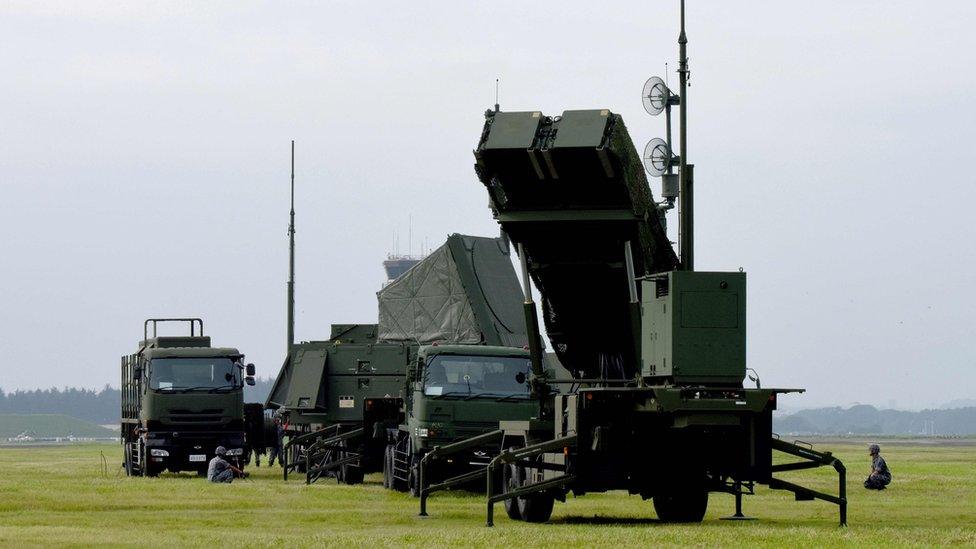North Korea: What could tip the balance
- Published

Refining its nuclear capabilities is key to Pyongyang
During the Cold War, nuclear strategists frequently asked "how much is enough" to guarantee deterrence and the security of the nation. Planners in Pyongyang may be asking the same question now.
After all, Wednesday's dramatic launch by North Korea of its new Hwasong-15 long-range missile is, in the eyes of some analysts, capable of striking as far afield as Washington or New York.
After six nuclear tests since 2006 and more than 20 missile launches in 2017, could the North have reached a point where its military advances give it a de facto nuclear deterrent credible enough to discourage the US from ever attacking North Korea?
The question is not an academic one.
If Pyongyang feels secure - and the North's leaders have routinely claimed that their nuclear and other Weapons of Mass Destruction (WMD) assets are purely for defensive purposes - then presumably Kim Jong-un can negotiate from a position of strength with the US to secure a relaxation of economic and political sanctions.
Such talks would allow Mr Kim to realise his twin strategic priorities: military modernisation and sustainable economic growth - in the process bolstering his leadership legitimacy in the eyes of his people.
A prelude to further testing
Official North Korean news statements accompanying the missile launch suggest that the latest launch is the culmination of a long-term technological mission - in the words of Kim Jong-un it was "a significant day when the historic cause of completing the state nuclear force, the cause of building a rocket power was realised".
Yet, the test - another confirmation of the North's increasing technical sophistication - is most likely a prelude to further testing.

While the US and its allies worry that the North is inching closer to the date when it can put a nuclear warhead on an intercontinental ballistic missile (ICBM) and deliver it with a measure of accuracy against a US city, the evidence suggests that the North is at least months or possibly a year or two away from reaching this goal.
It will, therefore, need to test similar long-range missiles to refine its strike capacity, including developing the targeting, and heat-resistant, re-entry capabilities needed to guarantee a meaningful deterrent.
Keep in mind that testing military hardware has purposes beyond merely bolstering deterrence. It is a way of showing strength and resisting pressure from one's enemies.
North Korean officials frequently point out the need not to appear weak in the face of external provocation, especially from Pyongyang's historic adversary, the United States.
David and Goliath myth
President Trump's "fire and fury" warning that he may feel compelled to totally destroy" North Korea, his belittling of "rocket man" Kim Jong-un, tighter US and international sanctions, and the latest decision by Trump to re-list North Korea as a state sponsor of terrorism are all evidence in Pyongyang's eyes of hostile intent.
To President Trump, his tough language may appear like a shrewd negotiating tactic, putting pressure on both the North and on China to end the current deadlock, but it is woefully short-sighted and unimaginative not to consider how the actions may be seen from the North's perspective.
One senior North Korean foreign ministry official has characterised Trump as "crazy… a complete thug… just a pathetic guy and a scattermouth".
In this context, and with the North's elaborate propaganda machinery at home mobilised single-mindedly in gearing up its population for a prospective war with the South, there seems very little reason for the North to refrain from further tests.

North Korea is constantly gearing up its population for a prospective war
More tests strengthen resolve at home and demonstrate the country's capacity to stand up to the US.
Pyongyang's narrative of resistance against the US imperialist is a simple, if not simplistic (and at heart disingenuous) re-telling of the David and Goliath myth in which the North is depicted as a plucky and resilient small state standing up to an international bully.
Trump's careless tweets and public bluster only serve to bolster this narrative.
Tipping the balance
For now, there are no signs that the North wishes to engage in substantive dialogue with the US; nor has it shown any willingness to respond to the freeze-for-freeze initiative proposed by both China and Russia in which the North would suspend testing in return for a halt to US-South Korean joint military exercises.
The region can take some, very limited, comfort from signs of partial restraint by Pyongyang. The latest test is the first since 15 September and marks therefore the end of almost two and a half months of relative quiet on the peninsula.
There appears too to be a method and coherence in Kim's approach. He has, so far, refrained from red-line crossing provocations, such as missile launches at Guam or Hawaii.

The launch of the Hwasong-15 missile, said to be capable of reaching all parts of the US
But how long will this last?
An atmospheric nuclear test remains a possibility, and there are other low-level provocations such as a cyber attack on US and South Korean command and control capabilities, or a maritime clash around the Northern Limit Line to the west of the peninsula, that might prompt a proportionate but unambiguously tough US and South Korean counter-action.
This in turn could be misread by the North as the prelude to more substantive military action and heighten the risk of low-level conflict escalating into something much bigger and mutually destructive.
In these situations, as in testing, the question of sufficiency remains paramount.
What one side sees as the minimum to protect its interests and a cautionary warning to its opponent, the other can easily view as a step too far and a deliberate provocation.
Such actions may be enough to tip the balance all too easily away from stability and predictability into uncertainty and escalation with potentially catastrophic consequences.
Dr John Nilsson-Wright is a Senior Research Fellow for Northeast Asia, Asia Programme, Chatham House and Senior Lecturer in Japanese Politics and the International Relations of East Asia, University of Cambridge.
- Published30 November 2017

- Published29 November 2017

- Published15 September 2017
